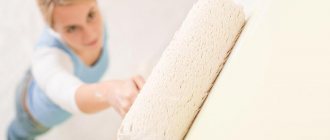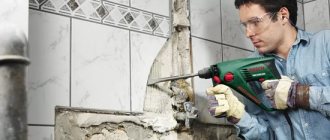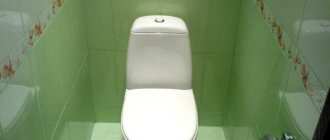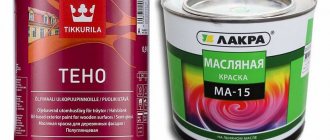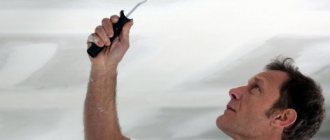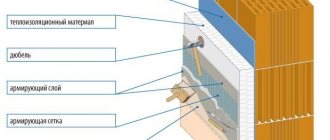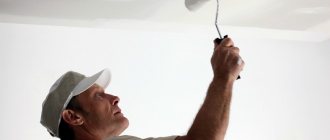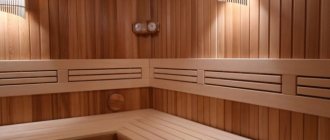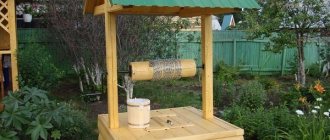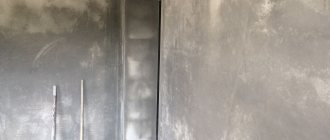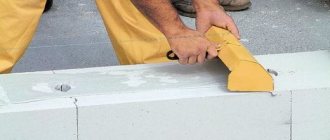Preparing the surface for an opaque coating
Before covering wooden structures with a protective composition, it is necessary to prepare the surface. This will make it smooth and beautiful. When applying an opaque coating, the principle of leveling and smoothing the structure is not important. It will be painted, but no one will see the base.
So, to prepare the surface we do the following:
- we clean it with a plane;
- scrape and sand with fine-grained sandpaper;
- prime the product (with drying oil, enamel, varnish). In order for the composition to penetrate deeper into the pores, it is necessary to add a solvent to it, for example, “White spirit”;
- fill all chips, cracks and depressions;
- sand everything down with sandpaper.
If desired, you can make the putty yourself. To do this, pour any fine-grained powder with a primer: flour, talc, starch, sawdust, etc. The resulting mass should have the consistency of thick dough.
Review of the best manufacturers of facade paints for wood, how to choose so that they last a long time
Among the many manufacturers, both leading and newcomers in this field stand out. The quality of their products is determined by technical performance and rich variety. Each of the manufacturers listed below has its own arsenal of paints for any purpose.
- Finnish manufacturer Tikkurila. Perhaps this is the most recognizable brand due to its polyurethane, acrylate and alkyd paints. For additional protection of wooden products, the company offers a wide range of protective products. Another category of materials can withstand even the lowest temperatures in the harsh North.
This is the most recognizable brand due to its polyurethane, acrylate and alkyd paints. - The products of the Slovenian manufacturer Belinka are resistant to the appearance of fungi, mold and other microorganisms. The service life of the material is at least 15 years. Known for their pigments that highlight the natural structure of wood.
The products of the Slovenian manufacturer Belinka are resistant to the appearance of fungi, mold and other microorganisms. - Drevoplast products are aimed at protecting wood from negative influences. The wide range is suitable for processing both external and internal wooden surfaces.
Drevoplast products are aimed at protecting wood from negative influences.
For a longer period of use, it is better to give preference to Teknos products. Unlike other manufacturers, Teknos paints have a higher cost, but their service life is at least 30 years. The product is suitable for painting premium wood.
For a longer period of use, it is better to give preference to Teknos products.
Preparing the surface for a transparent coating
Before covering the wood with transparent compounds, it is also necessary to prepare it. You need to perform the manipulations described above, but you will have to work more carefully. To begin with, we perform sanding in two passes: rub the surface, moisten it with a rag (to raise the lint), wait for it to dry, and sand again.
If there are small defects, we cover them with putty that matches the color of the wood. We level the composition while it is wet. To obtain a high-quality coating, you must use special grinding machines.
If there are pores, rub the surface with a mixture that you can make yourself. We take grated pumice, fill it with varnish and apply it to the product. We remove the excess immediately, and after drying we sand it.
Recommendations for application
It is important to know not only what to use to protect wood from moisture, but also how to do it. There are a number of recommendations, following which will help achieve the greatest efficiency from wood impregnation:
- Water-based impregnations (especially antiseptics) should not be used where they will come into direct contact with moisture. They are suitable only for interior decoration of residential premises.
- For exterior decoration and for bathrooms, it is recommended to choose non-aqueous compositions (oil or alcohol). They withstand prolonged contact with moisture.
- Oil impregnations change the color of wood (most often it becomes darker), so they are best used in combination with decorative ones.
- Preparations based on organic solvents are suitable for both interior and exterior decoration. They are non-toxic and have good water-repellent properties.
- To treat wood buried in the ground (piles, pillars, etc.), tar is often used. It is not environmentally friendly, but for underground structures this is not important. The use of tar allows you to reduce the consumption of antiseptics and save a lot.
Here are some more tips on how to properly apply impregnation to wood:
- It is recommended to wear rubber gloves and goggles, and a respirator is also a good idea;
- before processing, the wood must be cleaned of previous coatings, dust and dirt;
- impregnation is most often applied with a brush or roller, but you can also use a regular sponge - this does not interfere with effectiveness;
- to cover large surfaces it is better to use a spray bottle;
- It is better to impregnate wood in warm, dry weather, and the wood itself should also be dry.
An important point is that the impregnation must be applied according to the instructions. There is no need to make additional layers and exceed the consumption of the drug; this does not increase its effectiveness in any way.
Antiseptics
To increase the service life of the product, it is necessary to use an antiseptic for wood. For exterior work and interior decoration you will need different compositions. The main requirement for them is safety for health (especially when temperature or humidity rises).
Depending on the composition, wood antiseptics are divided into: water-soluble, organic-soluble and oil-based. Water-soluble products can be used if the surface will not come into contact with moisture. The following components are used in their manufacture: sodium fluoride and silicofluoride, BBK-3 (a mixture of borax and boric acid). The final coating should be varnish or other waterproof material.
Solvent-soluble compounds are used only as an antiseptic for wood for external use. They cannot be used indoors due to their highly toxic composition (contain a solution of pentachlorophenol copper naphthenate). The product penetrates well into the wood and strengthens its fibers. After application, the product takes on a green tint, and its adhesion also deteriorates.
Oil antiseptics consist of: coal, anthracene or shale oil. After using them, the wood darkens and a specific smell remains. But the treated coating is not afraid of moisture. The products are suitable only for external work: for the foundations of log houses, sleepers.
The most popular antiseptics for wood:
- “Nortex” (copes well with fungus and protects against woodworms).
- "Senezh" (provides maximum protection against mold, mildew and bugs).
- "Aquatex" (resists mold, mildew and ultraviolet radiation).
- "Ticurilla" (contains acrylic with alkyd, and protects against fungus and mold).
Popular antiseptics
There are many different impregnations on the market, and a particularly wide selection of antiseptics. To choose the best way to cover wood indoors and outdoors and protect it from rot and moisture, it’s worth considering and comparing different popular products.
Neomid Bio Color Aqua
This water-soluble product is excellent for protecting any wood from moisture. Neomid mixtures are often used for coating fences, gazebos and technical buildings. The product provides excellent protection against ultraviolet radiation and is considered one of the most effective against insects.
Rhenocryl TL30 Standard
This impregnation is well suited for treating timber against rot, mold and fungi. Equally good for all tree species. Penetrates deep into fibers, helps regulate moisture and dries quickly. It is used for outdoor work, but due to its environmental friendliness it can also be used indoors. The only thing the composition is not suitable for is for coating wood that is in contact with the ground.
Dufa Woodtex
When the question arises of how to treat wood before painting it outdoors, the Woodtex mixture from the famous brand Düfa fits perfectly. It is suitable for all types of wood, for processing inside and outside. It is often used for log houses, facades, window and door openings, as well as chipboard and other tile materials. This drug does not prevent the wood from “breathing”. The disadvantages include fragility - it must be processed regularly.
Dufa Dufatex Aqua
You can treat any wood against rotting and moisture using the Düfatex Aqua mixture. It is decorative and offers a wide selection of shades that imitate the colors of noble breeds. The product can be used to treat any structure, including the inside. It is safe for people, animals and plants. Any lumber and boards can be treated against rotting, not just “clean” wood.
Ace WOOD Royal Deck Siding
This American mixture is a popular option for treating any wooden structure. It is decorative, but thanks to the addition of polyurene and wax it also provides excellent protective properties. It is most effective against ultraviolet radiation and precipitation. An important nuance - it cannot be used on painted or stained surfaces.
KRASULA
A decorative mixture, but it also protects the tree well from the influence of atmospheric influences. Suitable for internal and external processing, it allows you to tint any breed to look like a valuable one. Has good antiseptic properties. It is characterized by low consumption - on average only 90 ml/m2 is spent.
Pinotex Standard
Treating wood against rot and moisture with Pinotex Standard is a good option for interior decoration. This impregnation is completely safe, suitable even for a children's room. The coating is semi-matte and effectively emphasizes the wood texture. Long-lasting product - retains characteristics for up to 6 years. Can also be used for external treatment, but only in combination with a primer. A good option for impregnating wood from moisture and rotting, thanks to its very economical consumption.
Pinotex Ultra Lasur
Antiseptic impregnation for external use, characterized by high resistance to solar radiation. Excellent UV filters make this composition the optimal choice for facades, fences, the outside of doors and window frames. One of the best options for treating wood outdoors.
Senezh Ognebio Prof
Complex impregnation to protect any wood from rotting and moisture. It is not only fireproof, but also moisture resistant, and also protects the tree well from temperature changes. This wood treatment liquid is odorless and dries quickly. The downside is high consumption.
Tex Biotex
A truly universal impregnation is an excellent option for treating boards against rotting and moisture. The drug is domestic, but it is made on European equipment, so its quality is not inferior to more expensive analogues. Can be used in high air humidity, but it is better to apply a primer mixture before use. Among the disadvantages is a pungent odor that lasts until it dries.
Flugger Wood Tex Transparent
A transparent semi-matte mixture that effectively protects wood from moisture and rot. But its main task is decorative. If you need to emphasize the texture of growth rings and the original wood texture, this is one of the best options. Excellent for log houses and wooden facades.
Goodhim TEXTURE 651
If you are interested in the durability of the impregnation, then Goodhim is an excellent choice. Formally decorative, but has good antibacterial and water-repellent properties thanks to wax components. Suitable not only for wood, but also for particle boards. The only thing this product is not suitable for is covering the floor. Odorless, sold in white and colorless versions.
Tikkurila Eko Wood
The famous brand Tikkurila produces preparations that can easily be used to treat wood from moisture and mold. The mixture is translucent, emphasizes the texture of the wood and protects against the effects of water and ultraviolet radiation. Protection against fungi and mold is almost 100%, which is one of the best indicators on the market. Moreover, this impregnation lasts longer than 5 years.
Extreme Climate
High-quality impregnation to protect wood from moisture and rot. Suitable for any breed, applied both outside and inside. The name Extreme Climate is given for a reason - this impregnating agent is most effective against changes in weather and temperature conditions.
Paints
After applying antiseptics, the surface is often painted. Paints are needed to protect against: moisture, insects and bacteria, sunlight, abrasion and mechanical damage. They also make the product look more aesthetically pleasing. Let's try to figure out which paint for wood is better.
Depending on the composition, they are: acrylic, alkyd and oil. Acrylic paints are used for finishing the facades of wooden buildings and are in great demand. They are great for cold regions as they have very good protective properties. The compositions are practically odorless, increase the service life of products, allow structures to “breathe”, and do not allow moisture to pass through.
Alkyd paints are in demand due to their low cost. They have a resinous base that forms a crust on the surface and is not absorbed into the wood. The composition protects from moisture and can withstand temperatures from -30 to +90 degrees. The coating will last a maximum of 7 years. Thorough drying is required after application, otherwise bubbles will appear.
Oil paints are considered the worst because they have an unpleasant odor and a toxic composition (due to drying oil). They are expensive because they consist of expensive components. The painted coating does not look very aesthetically pleasing and practically does not “breathe”. As a result, after some time it begins to crack and peel. To apply paint you will need a perfectly prepared surface. The coating will last a maximum of 5 years.
When choosing paint you should consider:
- penetrating ability and resistance to temperature changes;
- vapor permeability (will help protect against rotting);
- service life (this determines how often the coating will have to be renewed);
- environmental friendliness (especially when carrying out work inside the house);
- elasticity (responsible for resistance to cracking);
- drying time;
- fire resistance.
Why and from what you need to protect the lining
As a result of exposure to precipitation and ultraviolet radiation, wood turns gray and completely loses its decorative effect. But even indoors, wood fades, can become moldy, and becomes dirty. Contaminants are absorbed into the pores of the wood. As a result, dirt can be difficult to remove. Especially grease stains or stains from colored foods (tomato, coffee, compote). Steam, boiling water, and alcohol have a bad effect on the condition of wood.
Therefore, the lining is protected with a decorative coating. Varnishes, paints, oils, waxes protect wood from dirt, abrasion and mechanical stress. And they not only preserve the beauty of the tree, but also emphasize its color and texture. And they give the desired sophisticated touch. With tinting you can:
- paint the lining in colors characteristic of exotic wood species;
- enhance the natural color of wood;
- show the texture of the wood;
- grow old;
- bleach;
- paint in a bright color, unusual for natural materials;
- add gloss or matte texture.
Lucky
Instead of paint, you can coat the wood with varnish, which will protect it from rotting and precipitation. Using the material, you can carry out both external and internal work (this is written on the label). They can cover individual elements or entire buildings, for example, cabins, verandas, wooden gazebos. What varnish should I coat them with? Let's try to figure it out below.
The following types of varnishes exist:
- Alkyd. Consists of alkyd resins and solvent. The composition dries in 72 hours, but you can speed up drying if you purchase a product with a hardener (it will set in 24 hours). Alkyd-urethane varnishes dry in 12 hours.
- Oil. Consists of oils (in high concentrations), resins and solvents. The product changes the shade of the product from pale yellow to dark brown. The main disadvantage is the long drying time - in some cases it may take several days.
- Nitrolac. Contains colloxylin, resins, plasticizers and solvents. The compositions are often used for finishing work inside a building. They also have good strength, moisture resistance, and dry quickly (only a few hours). It should be remembered that the product contains toxic solvents, so it is not suitable for children's rooms.
- Acrylic. Does not contain organic solvents, so there is virtually no odor. Such varnishes can be used indoors as they are safe for humans. They are durable, do not change the color of the wood, but are afraid of temperature changes and moisture.
- Epoxy. Dries quickly and is suitable for any surface. With its help you can perform both external and internal work.
- Polyurethane. Resistant to wear and not afraid of moisture. Often used as a finishing coating for wooden products (especially valuable species);
- Yacht. Combines very high strength, elasticity, hardness, resistance to temperature changes and aggressive environments.
Further prevention from rotting
Once rot appears on the wood, the only way to protect it is to use impregnation. But you can also take preventive measures to avoid rot and mold. The most effective prevention methods are those that are used before construction:
- it is necessary to dry the wood for about a year, storing it in a ventilated room or under a canopy;
- You can speed up drying with a heat gun or any source of hot air;
- you can cover the wood with liquid paraffin and bake it in an oven for several hours - waxing provides good protection from moisture;
- Boiling in flaxseed oil works well against wood mold - no longer than 30 minutes.
In addition, various types of wood, impregnated with water, can be additionally coated with decorative impregnation. This drug not only improves appearance, but also provides additional protection. It should be applied after the first product has completely dried.
Fire retardants
Before covering the wood with a finishing finish, it is necessary to use fire retardants. They are necessary to reduce the release of flammable substances and prevent combustion without a source. They can be used in heated rooms (not resistant to precipitation), as well as outside (weather resistant).
Depending on the area of application, fire retardant compounds are produced in the form of:
- varnishes that form a thin film on the surface, it has no color and preserves the texture of the wood;
- paints and enamels - they leave a thin opaque film on the product, which can have different shades and protect not only from fire, but also from moisture;
- pastes and coatings - they differ from paints in that they form a thicker coating and contain coarse fillers (does not look very aesthetically pleasing);
- impregnations that can be applied to the surface of the structure or under pressure (using special devices).
Wax
The environmentally friendly coating can be applied to clean wood or after tinting with water-soluble compounds. The waxed surface becomes especially smooth, velvety with a soft shine. Wax favorably emphasizes the texture of wood and forms an elastic, breathable film. It can have different colors and at the same time tint the wood. It also protects it from moisture and biological damage. But it does not protect against mechanical influences. Each scratch will have to be waxed over again.
Interior decoration and exterior decoration
The basic materials for processing wooden products have been described above. Let's try to figure out how and with what to cover the wood inside the house. For interior decoration, it is better to choose products that are water-based, odorless and do not release toxins. They must also withstand moisture well.
We process wood as follows:
- apply an antiseptic and wait for it to dry;
- We use fire-resistant impregnation;
- cover with varnish or paint of any shade you like.
- When applying an antiseptic, you must follow some rules:
- first treat areas affected by fungus, rot or insects;
- clean and degrease the product in advance;
- work at air humidity no more than 80%;
- cover with fire protection only after antiseptic.
- Exterior finishing is also carried out in several stages:
- surface preparation;
- applying an antiseptic that penetrates deep into the wood;
- use of fire protection;
- finishing coating.
Any wooden building or product needs to be coated with an antiseptic (for example, stain). How to coat wood with this composition? We take a brush and carefully move it along the grain of the wood. It is better to process vertical surfaces moving from bottom to top. This will prevent drips from being absorbed and will ensure an even coating. To avoid stains on it, do not touch already painted areas. Apply the first layer of antiseptic, dry it, smooth it with sandpaper and cover it with a second layer.
Review of compositions for exterior wood finishing
Protection of wood material from adverse environmental influences must be of a complex type, which means that it will not be enough to simply paint it or even impregnate it with destructive compounds against fungi and bacteria. To begin with, you should carefully prepare for processing, and first of all, dry the wood as best as possible.
Please note that only dry wood can be processed, and its humidity should not be higher than 14%, since this is the standard that was established according to GOST 17231-78 when carrying out external work.
Therefore, before thinking about the best way to cover a tree, you should first let the raw wood sit so that the natural moisture from it evaporates (this works in cases where the building is built from raw material). The drying time will largely depend on the initial humidity and cross-section of the elements.
For example, a log or timber may even take a whole year. You cannot paint products that show traces of mold, so first you will have to get rid of it. But grinding the surface, which is done before you cover a wooden bench on the street or any other structure made of wood, will make it possible to significantly reduce the consumption of impregnation.
Types of protective impregnations
The main purpose of treating wooden street structures is to protect them from moisture, as well as from biological influences. For this reason, formulations with antiseptic properties should be used.
On sale you can find products on different bases:
they do not smell, dry quickly, but are not able to penetrate deep into the structure of the material, which means they are not able to protect wood from getting wet. For this reason, the material is most often used for interior work.
Water-based impregnations- Substances based on organic solvents , on the contrary, have deep penetration properties and can therefore be used to protect surfaces that are in direct contact with a damp environment. They will have a strong chemical smell that will dissipate as they dry.
- Oil compositions are also able to penetrate deep into wood fibers, and prevent cracking of the material, and also perfectly protect against dirt, moisture and dust. This is an ideal tool when you need to decide how to cover a wooden porch near a private house or even the floor on a terrace 0. They will be pleasant to walk on barefoot and easy to wash.
- Wax impregnations help create a thin, impermeable film for water on the wood surface. They can only be applied as the last layer, because no other composition is able to adhere to such a film.
- Varnishes can also form a dense film and partially penetrate deep into the wood. This protective and decorative product is universal, and gives the surface smoothness and also protects from precipitation.
There are also special types of impregnations with specific functions, for example, compositions that are needed to treat the ends of a freshly cut log house built from logs or timber. Due to uneven evaporation of moisture, they crack severely, and due to the duration of the process, which can last more than a year, they are affected by mold.
Anti-rot preparations that prevent shrinkage cracking will help get rid of this problem. Some structural elements require particularly serious protection. These include the lower crowns of log houses, subfloor boards, logs, support pillars, etc. In addition to atmospheric moisture, they can also be affected by soil moisture, which can cause rapid biological destruction. For this reason, strong preservatives that do not wash out are required.
But before covering a wooden porch on the street or the first log crown of rounded logs, which in the future will not be painted with covering compounds, you should think carefully. The thing is that such products contain compounds that can change the shade of the wood and give it a greenish tint. The products include Prosept Ultra, Senezh Antiseptic, Kedr Bio Prof, Neomid 430 eco and others.
Helpful advice! To treat those parts of the wood that will be in direct contact with the ground (for example, we are talking about the bottom of fence posts), it is worth using birch tar, or better yet, using bitumen or even tar.
A separate type of wood finishing is bleaching compounds. They can help remove traces of fungal damage from the surface that stains wood. Naturally, if it has not gone very far yet.
Among them are:
- Chlorine bleaches are a way to burn out microorganisms, but at the same time they will destroy the resins and tannins that are in the wood, which will disrupt the structure of the material.
- Oxygen bleaches - their action is softer, but the products are much more expensive and more difficult to use.
To clearly see the effectiveness of wood bleaches, we suggest watching the video. When choosing a product for treating wood outdoors, to reduce the risk of wood fire, you should pay attention to fire retardant impregnations.
They will be needed to protect gazebos with barbecues, buildings or even bathhouses that come into contact with open fire. Like compounds with preservatives that do not wash out, they contain coloring agents for the material, but at the same time give the wood a pleasant, even beautiful pink tint. It is easier to change it using a subsequent decorative type coating.
Please note that since outdoor structures in any case require protection from rotting, it is worth choosing not a special fire retardant agent, but a composition that has the function of protecting against bio-organisms and fire.
Decorative products
All decorative compositions for wood used in exterior work have certain protective properties. Some due to the creation of a waterproof film on the surface, and others due to special additives. But such a statement will only apply to those drugs whose packaging is marked for external use.
If it is not there, then you should definitely treat it with an antiseptic before starting to coat the material. Decorative compositions include all the above-described products that have the effect of tinting the material. We are also talking about transparent impregnations with an ultraviolet filter - it will absorb the sun's rays and allow you to preserve the natural shade of the wood.
Decorative coatings include various types of paints and varnishes:
- Water-dispersed ones are characterized by excellent environmental friendliness, durability, resistance to weather conditions, dry quickly, mix well with colors to obtain the desired color, and do not hide the wood structure. If you need to decide what exactly to treat a wooden bench on the street, a structure on a playground or a swing, then you won’t find a better product, however, such paints are very expensive.
can be translucent and covering, glossy and matte. They perfectly protect wood from mold, rot and insects. It may take several hours to dry.
Decorative acrylic paints,- Oil paints have recently been the most popular for exterior work, but now they are used extremely rarely and often only for painting minor structures that do not claim attention. The main advantage is its low cost, but the paint is toxic, and the coating created with its use is short-lived - under the influence of external factors it will quickly begin to peel off the surface and peel off.
- Alkyd enamels, as well as oil paints, are capable of forming a glossy, dense film that will not allow water to pass through and will be resistant to mechanical damage. They are still capable of emitting a sharp, unpleasant aroma when applied, which disappears completely after drying. But such compositions are more durable, and after time they will not change color due to exposure to sunlight.
- Polyurethane enamels are the most resistant to abrasion, stress, and durable. An excellent solution to the problem of covering a wooden porch or decking near a pool.
In addition to paints, wood can also be protected outdoors with decorative varnishes. Like paints, they can be water-based or even synthetic-based. Water-based ones dry quickly, create a matte finish, and are most often used in areas that are protected from direct atmospheric exposure by canopies. Polyurethane varnish with a glossy texture has excellent performance characteristics; the most durable and durable coating is a coating with deck or yacht varnish.
Furniture processing
It often happens that old furniture needs restoration. As for new products, if you manufacture them yourself, you will have to think about their protection from moisture, rot, and insects. All this can be done using special compounds. For example, let's try to figure out how to cover a wooden table. For work you will need: a brush or roller, protective equipment (respirator, gloves, goggles), sandpaper and a rubber spatula.
We perform the following actions:
- Preparing the surface. We clean the old coating using chemical or thermal cleaning;
- Apply primer. It improves the adhesion of the paint and varnish composition to the product;
- We fill all cracks and defects;
- Cover with paint or varnish. The choice of material depends on the operating conditions of the product.
Preliminary processing
The preparatory process before coating a wooden surface with varnish consists of:
- Thorough cleaning of surfaces, removing dust, dirt and old paint. This stage is required, otherwise the coating made with varnish or stain will be uneven and will soon begin to collapse.
- Applying a protective agent. Which product is best suited in each specific case is influenced by the conditions in which the object being painted will be used.
- Primer treatment. This is required to improve the adhesion of the varnish to the wooden surface. For interior work, it is permissible to use only water-based products with a non-toxic composition.
Fence processing
Wooden structures exposed to the open sky eventually take on a dull gray hue. Therefore, you need to cover them with protective compounds that will extend their service life. How to cover a wooden fence? Impregnation will protect the structure from microorganisms, paint - from sunlight and moisture.
We carry out the work in the following order:
- we clear the area near the fence, trim the interfering plants;
- remove the old coating (if any), sand it with sandpaper,
- treat with a primer and fill all cracks with putty;
- we cover the fence with an antiseptic that is not afraid of temperature changes, moisture, etc.;
- dry and apply paint or varnish.
Oil-based compounds adhere well to the surface, acrylic ones are inexpensive and dry quickly, alkyd ones will have to be updated frequently. If the choice falls on varnish, then it is better to choose alkyd (safe) or polyurethane (very durable).
Not a single plot of land would be complete without wooden structures. To understand how to paint wood, you need to check what is available in the store and read the instructions for different materials. This will help you make a choice, because now there are many paint and varnish compositions for interior and exterior work.
Harmful effects on the fence
Wood is traditionally the most common construction and finishing material in Russia. Both the houses themselves and their fences are constructed from it. But this material is not resistant to many external influences.
Processing wooden pickets
Fence wood must be protected from the following negative factors:
- Exposure to harmful microorganisms. These are pathogenic fungi: blue, rust, green, black, white mold, as well as putrefactive bacteria. Their mycelia and colonies, growing, first change the color of the organic matter (it begins to turn black). And then rot eats it, turning it into dust. Harmful microorganisms appear due to excessive moisture in the wood. This environment is favorable for their reproduction.
- Life activity of harmful insects. Beetles - weevils, bark beetles, borers and others - destroy the tree, eating through many passages in it. Many types of insects are carriers of spores and bacteria, and therefore are capable of starting the process of decay.
- Climatic and weather conditions: wind, showers, temperature changes. In this case, wetting/drying and expansion/contraction of the material alternate. In the winter season, freezing of moistened wood is added to all this. It leads to rupture of cellulose fibers, the material begins to darken, crack and collapse. Sometimes moss appears on it.
- Solar ultraviolet radiation is also harmful to wood organic matter. It decomposes the lignin contained in it, which is a natural polymer. This substance structures the fibers, gives the wood hardness and tone. From prolonged exposure to direct sunlight, the fence fades and then acquires a grayish color. Organic matter becomes covered with numerous cracks, and its structure becomes loose. Only an opaque coating can preserve a wooden fence and protect it from ultraviolet radiation.
- Open fire. If there are buildings close to the fence, then it is advisable to cover it with fire protection. This is done by impregnation with a fire retardant.
Waterproofing of pillars
Bottom line: the main enemies of a wooden structure are atmospheric moisture, pathogenic microorganisms, ultraviolet radiation, harmful insects and fire.
If you do not protect against them, the fence will not last even 5–7 years. Treating a wooden fence will extend the life of the structure for many years.
It is also worth paying attention to the fact that harmful insects already live or appear in the wood under the intact bark, feeding on its thickness. The beetles and their larvae die in the debarked material.
Based on this, you should not store slabs and unedged boards on the street for a long time. The bark must be removed from them.
Antiseptics for treatment
How to paint a wooden facade yourself
If there is a need to paint the facade of an already used house, it is quite possible to do this work yourself. To do this, you need to take care of having free time, you will need a lot of it. Purchase consumables in advance: primer and paint in the required volume, coloring pigment (color) and solvent as needed. The approximate consumption rates of the compositions and the service life of the coating are in the table below.
Table 2. Composition consumption rates and coating service life
- Type of paintworkConsumption (g/m²)
- Service life (years)
| Silicone | 150 — 200 | 20 or more |
| Alkyd | 100 — 120 | 20 |
| Acrylic | 130 — 200 | 15-20 |
| Oily | 100 | 2-3 |
| Water-dispersed | 110 — 130 | 20 or more |
Scaffolding is very convenient for working at height.
In order to put the facade in order, in addition to materials, you will need the following tools:
- stepladder or scaffolding,
- different brush widths,
- rags
- Angle grinder (grinder) with discs for grinding,
- putty knife,
- construction mixer with an attachment for mixing paint.
Depending on the type of paint used, you will need various personal protective equipment: gloves, a respirator, goggles.
Wood paint colors
A well-chosen shade can enhance the natural color of wood. In some cases, it is the color scheme that helps protect the coating from environmental influences.
For example, light shades are considered resistant to sunlight, and gray colors retain their original shade without acquiring the characteristic yellowness of time. In terms of architectural solutions to visually increase the size of an object, experts advise choosing light colors.
A well-chosen shade can enhance the natural color of wood.
When choosing paint for exterior woodwork, you should pay attention to the composition and manufacturer’s recommendations indicated on the label. In the absence of a detailed answer, you can contact the manufacturer through the official website. The quality certificate says a lot about the quality of the product.
